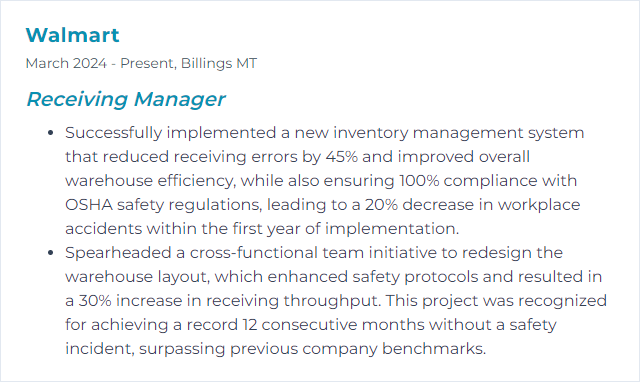Top 12 Receiving Manager Skills to Put on Your Resume
In today's job market, you need more than a title to stand out for a receiving manager role. Put sharp, relevant skills front and center. Show how you command the dock, keep inventory tight, and lead people with clarity. That mix signals real impact to any hiring manager skimming your resume.
Receiving Manager Skills
- Inventory Management
- SAP ERP
- Oracle SCM
- Logistics Coordination
- Quality Control
- Microsoft Excel
- Warehouse Operations
- Forklift Operation
- RF Scanning
- Supply Chain Management
- Lean Principles
- Safety Compliance
1. Inventory Management
Inventory management, for a Receiving Manager, means controlling how goods arrive, get stored, and move onward—keeping quantities right, locations clear, and items available when operations need them.
Why It's Important
It keeps the whole machine humming. Accurate receipts, tidy storage, and reliable counts cut stockouts, curb overages, and speed up fulfillment. That saves money and headaches while keeping customers happy.
How to Improve Inventory Management Skills
Make receiving smarter, faster, more accurate with a few focused moves:
Leverage Technology: Use inventory software for real-time tracking of receipts, counts, and movements. QuickBooks and NetSuite are common options.
Regular Audits: Run cycle counts, spot checks, and periodic full counts to keep records honest and shrink under control.
Supplier Communication: Align on lead times, packaging standards, and labeling. Clear channels help resolve discrepancies fast. Harvard Business Review covers why this matters.
Just-In-Time (JIT) Inventory: Receive closer to need to trim holding costs. It demands tight planning and forecasting. Investopedia offers a clear overview of JIT.
Employee Training: Train receiving teams on SOPs, systems, and the why behind accuracy. Teach it, test it, reinforce it.
KPI Monitoring: Track stock turns, receipt accuracy, putaway speed, and backorders. The Balance SMB outlines common inventory KPIs.
Stick with it. The payoff is leaner stock, fewer errors, faster flow.
How to Display Inventory Management Skills on Your Resume

2. SAP ERP
SAP ERP (including SAP S/4HANA and legacy ECC) connects purchasing, inventory, finance, and more—so receiving data flows cleanly into the rest of the business. That means better traceability, fewer mismatches, and faster decisions.
Why It's Important
It standardizes receipts, strengthens inventory accuracy, and gives you real-time views of what’s inbound and what’s on hand. Less manual entry, more confidence in the numbers.
How to Improve SAP ERP Skills
Dial in configuration, training, and data capture to make SAP work for you:
Automate Data Entry: Use barcode or RFID scanning to post goods receipts faster and cleaner. SAP Extended Warehouse Management pairs well here.
Customize Workflows: Match SAP workflows to your receiving steps. Utilize SAP Business Workflow to align tasks, approvals, and alerts.
Enhance Reporting: Build dashboards and operational reports to track receipts, variances, and supplier performance. SAP Analytics Cloud brings flexible analysis.
Integrate Quality Management (QM): Trigger inspections at receipt and record defects within the process. SAP QM ties results to materials and vendors.
Use Advanced Shipping Notices (ASN): Get ASNs from suppliers so your team and system are ready before the truck arrives. SAP Supplier Relationship Management supports this.
Train and Support Staff: Offer recurring training and refreshers on transactions and mobile apps. SAP training and certification programs help standardize knowledge.
Leverage Mobile Solutions: Use SAP Fiori apps for receipts, putaway, and inventory lookups right on the floor.
Result: fewer keystrokes, faster receipts, cleaner inventory.
How to Display SAP ERP Skills on Your Resume
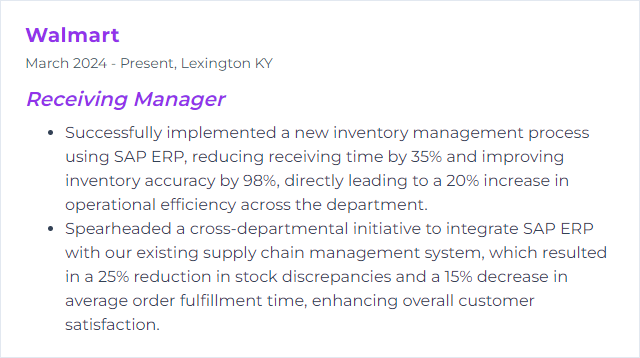
3. Oracle SCM
Oracle SCM ties together procurement, inventory, orders, logistics, and analytics. For receiving, it sharpens ASN handling, receipt posting, quality checks, and visibility across locations.
Why It's Important
It speeds receipts, improves accuracy, and powers data-driven decisions. Supplier collaboration gets easier. So do audits.
How to Improve Oracle SCM Skills
Make the platform do the heavy lifting:
Streamline Receiving: Use mobile receipt transactions and automated data capture to cut errors and time.
Adopt ASNs: Pre-stage labor and space using Advance Shipment Notices, minimizing dock congestion.
Boost Data Accuracy: Lean on barcode/RFID scanning within Oracle Inventory Management.
Optimize Inventory: Use Oracle SCM Cloud tools for min-max settings, safety stock, and replenishment logic.
Invest in Training: Keep the team current with feature updates through learning subscriptions and hands-on practice.
Use Analytics: Track receipt cycle time, discrepancies, supplier OTIF, and aging. Act on bottlenecks fast.
Clean data in, clean decisions out.
How to Display Oracle SCM Skills on Your Resume
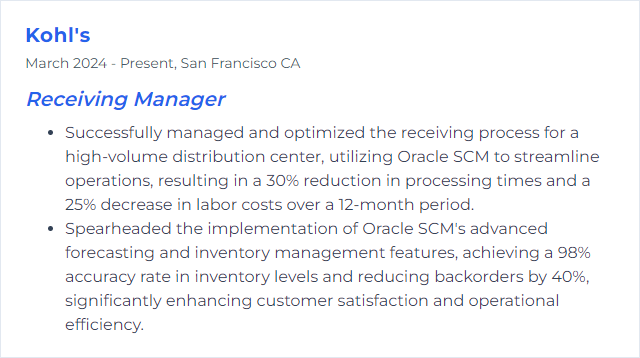
4. Logistics Coordination
It’s the orchestration of inbound flow. Scheduling trucks, syncing with carriers and suppliers, clearing docks, and slotting product quickly and correctly.
Why It's Important
Done right, goods arrive on time, inventory stays balanced, and orders don’t slip. Bottlenecks shrink. Teams breathe easier.
How to Improve Logistics Coordination Skills
Make visibility and communication your allies:
Streamline Communication: Create direct lines with suppliers and carriers. Tools like Slack help with quick updates.
Implement Technology: Use logistics platforms such as ShipBob or Logi-Sys to automate routing and scheduling.
Enhance Visibility: Track inbound loads in real time with systems like Track-POD so you can pivot when plans change.
Optimize Inventory: Apply lean inventory rules and systems like Fishbowl Inventory to keep counts honest and orders accurate.
Develop Strong Relationships: Keep feedback loops open with carriers, suppliers, and internal teams.
Continuous Improvement: Review KPIs and tweak processes. Tableau or similar tools can surface patterns fast.
Training: Upskill your team on current logistics practices via platforms like LinkedIn Learning.
Clarity kills chaos.
How to Display Logistics Coordination Skills on Your Resume

5. Quality Control
QC at receiving means verifying incoming goods meet specs and standards—before they contaminate stock, production, or orders.
Why It's Important
Stop defects at the door. You prevent rework, returns, and warranty pain, protecting cost and reputation.
How to Improve Quality Control Skills
Raise the bar with structure and feedback:
Develop Clear Standards: Document acceptance criteria by item, vendor, and risk level.
Supplier Collaboration: Work closely with suppliers to ensure they understand your quality requirements. Share issues promptly and agree on corrective actions.
Inspection Protocols: Use checklists, sampling plans, and escalation paths for nonconforming goods.
Leverage Technology: Quality systems help record results, trigger holds, and analyze trends over time.
Train Your Team: Teach inspection techniques and handling for rejects, holds, and rework.
Continuous Improvement: Adopt a continuous improvement mindset—review defects, fix root causes, verify results.
Feedback Loop: Share supplier scorecards and collaborate on prevention, not just detection.
The goal: fewer surprises, faster flow.
How to Display Quality Control Skills on Your Resume
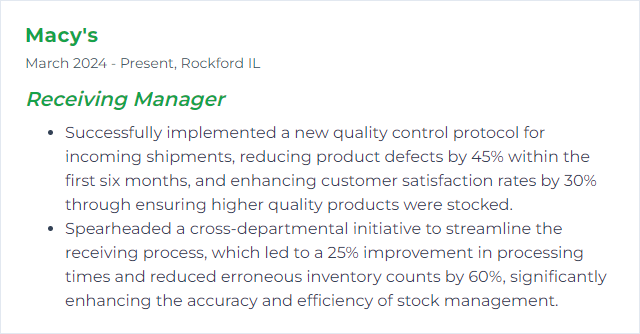
6. Microsoft Excel
Excel is the pocketknife: lists, counts, trendlines, dashboards. Track receipts, reconcile variances, build reports without waiting on IT.
Why It's Important
Fast analysis. Clean reporting. Nimble modeling. It helps you spot issues early and communicate clearly.
How to Improve Microsoft Excel Skills
Focus on what moves the needle for receiving and inventory:
Advanced Formulas: Master VLOOKUP/XLOOKUP, INDEX+MATCH, SUMIFS, COUNTIFS, IFERROR. ExcelJet has compact examples.
PivotTables: Summarize receipts, discrepancies, and trends quickly. See Microsoft’s PivotTable guide for structure and tips.
Data Validation: Lock down inputs to prevent bad data.
Macros: Automate repetitive tasks like daily receipt logs and discrepancy reports. Start with Microsoft’s intro to macros.
Power Query: Combine data from WMS/ERP exports and clean it in minutes.
Conditional Formatting: Flag low stock, aging receipts, or outliers without manual checks. Microsoft’s guide covers patterns.
External Data Connections: Pull data from ERP or databases to keep reports fresh.
Keep Learning: Sites like Excel Easy are great for quick refreshers.
Build once, reuse often.
How to Display Microsoft Excel Skills on Your Resume
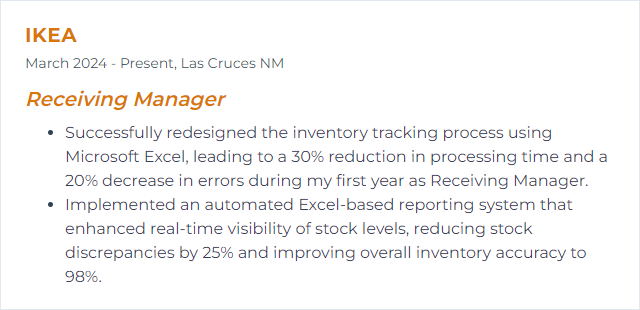
7. Warehouse Operations
Operations covers the nuts and bolts: receiving, putaway, storage, replenishment, and the handoff to picking and shipping. Flow, accuracy, safety—every day.
Why It's Important
Strong operations cut errors and cost, speed fulfillment, and keep the warehouse safe and sane. For receiving managers, it’s where your fingerprints show.
How to Improve Warehouse Operations Skills
Target clarity, speed, and safety:
Efficient Receiving: Use a WMS for real-time receipts and directed putaway to reduce travel and misplacements.
Smart Layout: Design for flow—clear docks, short putaway paths, fast-mover zones.
Standardize Work: SOPs for receiving, inspection, putaway, and exceptions reduce variability.
Invest in Training: Regular training on systems, handling, and problem-solving. LinkedIn Learning offers solid courses.
Safety First: Follow OSHA guidelines, run audits, and fix hazards quickly.
Lean Practices: Remove waste—excess movement, waiting, rework.
Tech for Accuracy: Barcode and RFID tools speed checks and cuts mistakes. Zebra Technologies is a common provider.
Continuous Improvement: Apply tools like Six Sigma to analyze defects and tighten processes.
Small tweaks compound into big gains.
How to Display Warehouse Operations Skills on Your Resume
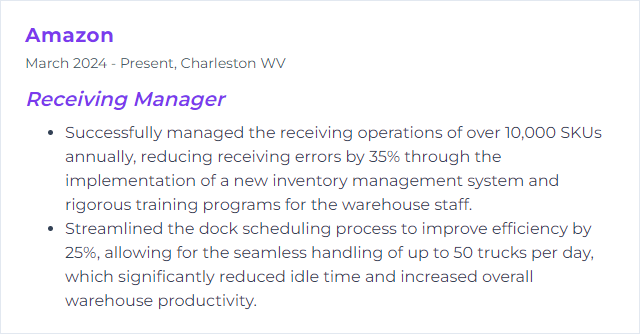
8. Forklift Operation
Operating forklifts safely and efficiently keeps product moving and people safe. It’s fundamental on busy docks and dense racks.
Why It's Important
Faster handling. Fewer damages. Lower injury risk. It’s where time and safety collide.
How to Improve Forklift Operation Skills
Make safety and consistency nonnegotiable:
Safety Protocols: Base training and rules on OSHA guidance. Reinforce regularly.
Preventive Maintenance: Daily checks and scheduled service reduce breakdowns and incidents.
Operator Training: Use comprehensive, OSHA-compliant certification programs; refresh often. CertifyMe.net offers resources.
Optimize Routes: Use WMS-directed putaway and intelligent tasking to cut deadhead travel. Oracle’s WMS platform is one example.
Ergonomics: Choose equipment with operator comfort in mind. Crown Equipment focuses on ergonomic designs.
Two-Way Feedback: Encourage operators to flag hazards or process friction early.
Measure: Track utilization, idle time, and near-misses with telematics to drive improvement.
Safe is fast in the long run.
How to Display Forklift Operation Skills on Your Resume
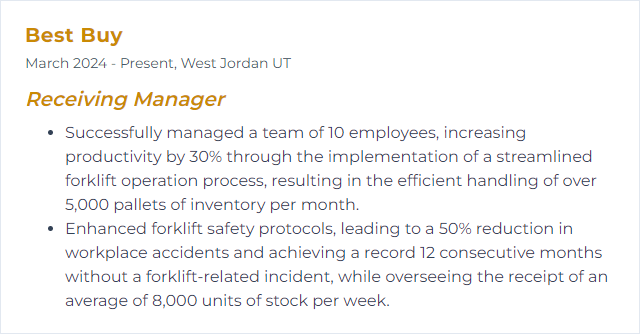
9. RF Scanning
RF scanning uses handhelds to capture barcodes and push data straight into your WMS. No double entry. Fewer mistakes. Faster pace.
Why It's Important
It tightens inventory accuracy and speeds receiving, which keeps the rest of the operation from tripping over bad data.
How to Improve RF Scanning Skills
Polish both the tools and the habits:
- Training: Teach scanning technique, device care, and exception handling.
- Equipment Maintenance: Keep scanners updated, batteries healthy, and spares ready.
- Process Optimization: Use zone assignments, task interleaving, and clear scan points to reduce walking.
- Technology Upgrade: Consider newer RF scanners with better ergonomics and battery life.
- Quality Checks: Add validation steps to catch mis-scans before they ripple.
- Feedback Loop: Let operators suggest layout or workflow tweaks to remove friction.
Clean scans, clean counts.
How to Display RF Scanning Skills on Your Resume
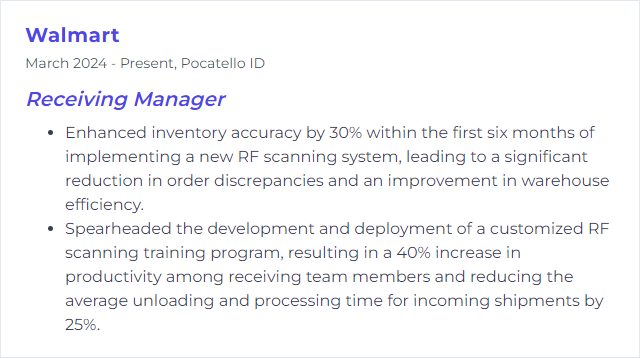
10. Supply Chain Management
SCM coordinates sourcing, production, and distribution. Receiving sits in the middle—verifying, storing, and releasing materials so upstream and downstream flow doesn’t stall.
Why It's Important
Good SCM trims cost, shortens lead times, and raises fill rates. You can forecast better and react faster.
How to Improve Supply Chain Management Skills
Tighten coordination and visibility:
Streamline Processes: Standardize how you receive and handle exceptions. The Council of Supply Chain Management Professionals (CSCMP) shares useful best practices.
Supplier Relationships: Collaborate routinely on OTIF, packaging, and labeling. The Institute for Supply Management (ISM) offers guidance on SRM.
Leverage Technology: Adopt WMS and SCM systems for real-time data and automation. Gartner’s research helps compare options.
Measure What Matters: Track receiving accuracy, dock-to-stock time, and supplier performance. APICS (part of ASCM) provides benchmarking resources.
Continuous Improvement: Train teams, pilot changes, and lock in what works. The Lean Enterprise Institute is a solid resource.
Better links across the chain, fewer surprises inside the building.
How to Display Supply Chain Management Skills on Your Resume
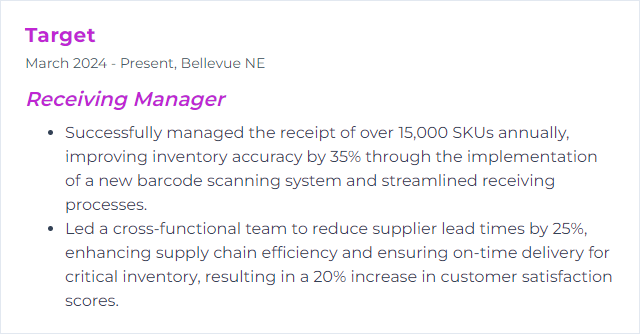
11. Lean Principles
Lean trims waste and elevates value. In receiving, that means fewer touches, simpler paths, and less waiting. Faster flow with steadier quality.
Why It's Important
Lean cuts costs and delays while lifting consistency and service. Less clutter, more signal.
How to Improve Lean Principles Skills
Start small, make it stick:
Value Stream Mapping: Map every step from truck arrival to putaway to spot waste. Lean Enterprise Institute has helpful guidance.
Kaizen: Drive frequent, small improvements. ASQ’s resources on Kaizen can help focus efforts.
Standardize Work: Create SOPs and visual aids so the best way becomes the normal way. Lean Manufacturing Tools offers examples.
Pull Systems (Kanban): Restock based on real demand signals. Planview explains principles well.
Root Cause Analysis: Use 5 Whys to fix causes, not symptoms. MindTools covers the method clearly.
Empower Teams: Give frontline staff the authority to improve their area. Lean Leadership Way Institute discusses approaches.
Visual Management: Boards and signals make work status obvious. Lean Smarts shows practical examples.
Lean Training: Keep learning through workshops and courses. Gemba Academy is a well-known provider.
Less waste, more flow.
How to Display Lean Principles Skills on Your Resume
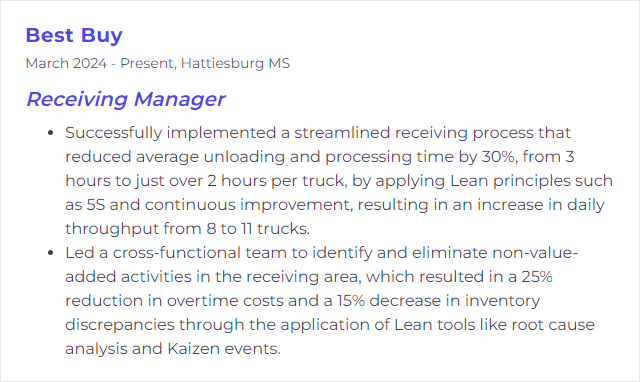
12. Safety Compliance
Safety compliance means your processes, equipment, and training meet rules and standards—so people go home whole and the operation avoids costly incidents.
Why It's Important
It protects your team, shields the business, and keeps work flowing. Accidents stall everything.
How to Improve Safety Compliance Skills
Build a system that people trust and follow:
Educate and Train: Provide regular, role-specific training based on OSHA guidance. Include temps and contractors.
Clear Protocols: Codify procedures for lifting, PPE, equipment use, and hazardous materials. The National Safety Council has useful references.
Regular Audits: Inspect, document, correct. SafetyCulture offers digital checklists to standardize audits.
Safety Culture: Encourage reporting and near-miss sharing without fear. NIOSH’s frameworks can help.
Stay Current: Track regulatory changes and update policies promptly via OSHA updates.
Leverage Technology: Use incident tracking and document control tools such as iAuditor by SafetyCulture to spot trends and prevent recurrence.
Safe habits, every shift.
How to Display Safety Compliance Skills on Your Resume
